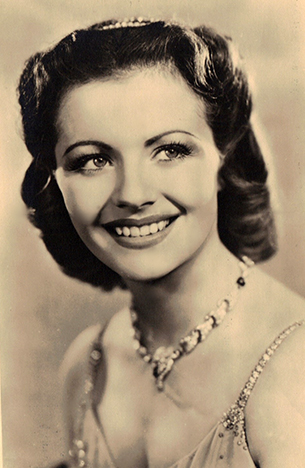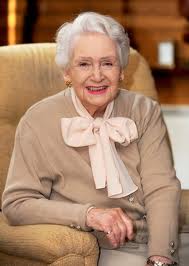
Researching my latest book, ‘Wealth and Notability: the Lockwood, Day and Metcalfe Families of Yorkshire and London’, unearthed some surprising new findings about Margaret Lockwood’s family background. She clearly knew much more than she was prepared to reveal in her autobiographies, or to her 1989 biographer, Hilton Tims.
My own book tells the story of an extraordinary group of families, and their contingent of successful and notable people. It is one of two books that has emerged from many years of painstaking research into my wife’s family history. We have long known she has a large number of both notable and notorious ancestral connections, far more fascinating than my own, and a frequent jest is that she could have a whole series of ‘Who Do You Think You Are?’ just to herself. One of her ancestral lines is the talented and influential Lockwood family of Doncaster, from which Margaret Lockwood was also descended.
The earliest Lockwood we can identify with certainty is Margaret Lockwood’s great-great-great-grandfather, Joseph Lockwood (c1758-1837), a self-made man, twice Mayor of Doncaster, builder, sculptor, monumental mason and part owner of the Levitt Hagg limestone quarries near to the town. Some of the neo-Hellenic memorials designed by him and his son, also Joseph (1785-1842), are still around, one being inside the Parish Church at Blyth in Nottinghamshire. They suggest an artistic talent that was passed widely on to their descendants, notably Margaret Lockwood’s great-grandfather, Henry Francis Lockwood (1811-1878), the architect responsible for the Gothic design of Bradford Town Hall, the Corinthian Bradford St. George’s Hall, the philanthropic company town of Saltaire, and around a hundred other public and private buildings in Yorkshire, London and elsewhere.

An impression of Bradford Town Hall on the laying of the foundation stone in 1870
Success is often seen to run in families, and so we should not be surprised to find that the elder and younger Joseph had other notable descendants. These include:
Sir Frank Lockwood Q.C. (1846-1897) who served as Liberal M.P. for York, and as Her Majesty’s Solicitor General. He led the prosecution of Oscar Wilde’s retrial in 1895. He was also well-liked for his humorous cartoons of courtroom and Parliamentary scenes, a further instance of the Lockwood artistic gene.
Louis Lockwood (1864-1907), another architect, who made a name for himself in St. Paul, Missouri. His houses, such as Jared Howe’s house in West Grand Avenue, are admired to the present day.
Sir Joseph Flawith Lockwood (1904-1991) who became head of the EMI corporation and was responsible, among other things, for the Abbey Road studios and dealings with The Beatles. He also served for a decade as chair of the Royal Ballet. One of his brothers, a businessman, was twice kidnapped by guerrillas in Argentina. Another brother founded the Lockwood Donkey Sanctuary in Surrey, and once threatened to sue the Queen and Captain Mark Phillips for cruelty when Phillips was riding the Queen’s horse in the Badminton Horse Trials.
The actor Timothy West. His father was also a successful actor, Harry Lockwood West (1905-1989), and earlier members of their family owned and edited the Doncaster Chronicle newspaper.
We should also mention Charles Day (c1783-1836), brother of the younger Joseph Lockwood’s wife, Susannah Day (1785-1857), who made a colossal fortune from ‘Day and Martin’ blacking. His wealth passed widely around the family, providing all kinds of social and educational privileges. Joseph and Susannah’s son, Henry Francis Lockwood the architect (Margaret Lockwood’s great-grandfather) married a first cousin who was also a member of the Day family, thus receiving a double share of Charles Day’s fortune. It seems likely that it was Charles Day who helped him train under one of the leading architects of the time, and Charles Day’s money that enabled him to set up his own architectural practice.

Henry Francis Lockwood (1811-1878), Margaret Lockwood’s great grandfather
As well as artistic talent, another trait that seems to run through the family is what I refer to as the ‘Lockwood jaw’. Many of them have a long lower jaw tending towards what dentists refer to as an underbite, which is often visible in family photographs. It is apparent in Henry Francis Lockwood on the back cover of my book, and especially in Henry’s granddaughter Constance Metcalfe Lockwood whose portrait appears on the front. Sir Frank Lockwood’s sister, Lucy Ellen and her son Frank Lockwood Atkinson had it, and the portrait of the elder Joseph Lockwood on the BBC Your Paintings website also shows indications. It still appears in some present-day descendants. I can probably get away with pointing to Timothy West as an example, but I won’t embarrass anyone else by naming names.
Margaret Lockwood’s own grandfather and father did not, however, have such successful lives. When Hilton Tims wrote his biography of Margaret Lockwood in 1989, there was no way he could have efficiently searched through overseas newspapers and other sources as the technology was not yet sufficiently developed, and so the life story of her grandfather, Francis Day Lockwood (1851-1907), was entirely hidden from him. He says simply that he “retreated into obscurity” and assumes he was earning a good living somewhere abroad as an architect.
In fact, although he did start out as an architect with his father, there is no evidence he actually qualified, and after his father’s death in 1878 he gave up the profession, and went off gold prospecting in New Zealand with two of his brothers. It seems possible that his wife, Sarah Maria Elizabeth Miller (1859-1893), went with him, but they returned around 1891. Francis then sailed off on his own to Perth, Western Australia, in 1892, leaving Sarah to die of chronic alcoholism in a London boarding house in 1893, and their son (Margaret Lockwood’s father) to be brought up by a relative, ‘technically orphaned’. If Sarah had indeed been to New Zealand with Henry, it seems likely it would have at least exacerbated her problems with alcohol, and could well have been the direct cause, because they suffered terrible privations there. One of Francis’s brothers was driven to suicide in 1886 in a near-inaccessible hut in the reefs at the end of the Wilberforce River, a remote area of the Southern Alps, and the other brother who went to New Zealand, died there in 1891, aged only 51, in the Christchurch hotel he ran.
On arriving in Australia, Francis first took a job as a hospital orderly, working ninety-hour weeks in terrible conditions. He then became a health inspector, and after marrying again in 1896, was appointed Chief Inspector to the Central Board of Health in Perth. Sadly, however, he appears to have driven himself obsessively into overwork, perhaps a trait we see later in his granddaughter, but in Francis’s case it brought mental breakdown, and he died by self-poisoning in Perth in 1907.
It is not clear whether Margaret Lockwood herself knew any of this, but had she done so, it is easy to see how it could have damaged the gloss of her film-star glamour. It would have been very much in her interests to keep it to herself.
What is undeniable though, is that she knew a lot more about her father than she revealed. Hilton Tims outlined the basic story, that Henry Francis Lockwood (1879-c1956, presumably named after his architect grandfather) had three wives, that he was a railway administrator in India, and that he had two other children, Margaret Lockwood’s brother ‘Lyn’ (1912-1987), and her half-brother Frank (1908-1979). But Tims’s account contains a number of errors and omissions.
Firstly, he tells us that soon after Henry Francis Lockwood’s first marriage in 1900, his wife, Jessie Ramsay, then “simply disappeared from the records.” Both Margaret Lockwood and her mother Margaret Evelyn, clearly knew that this was not the case. Jessie had at first travelled to India with Henry, but then returned because she could not bear the conditions and the heat, and lived out most of her life in London. Not only that, Henry and Jessie had a son, John Alexander Lockwood, born in London in 1898, before the marriage, registered with the surname Ramsay. Had Tims been able to search the 1901 census electronically, he would have found the three of them living at Kingston upon Thames, before Henry and Jessie left for India, leaving John with his Ramsay grandparents. Jessie later moved to York where she died aged 80, in 1957.
Various circumstances strongly suggest that John was indeed Henry’s biological son, which means that Margaret Lockwood had another half-brother not mentioned in any of her (auto)biographies and obituaries. According to his son, John actually met Margaret twice, once to sort out loose ends relating to their father’s estate, and again after Jessie’s death in 1957. John found these meetings disappointing, Margaret being neither as friendly, nor as glamorous as he had anticipated. John also very much doubted that his parents’ marriage had ever been legally annulled, which would have given Margaret Lockwood very good reasons for wanting to conceal his and Jessie’s existence.
Tims is also sketchy about Henry’s second wife, Marie Ann, who, he tells us, died shortly after Frank’s birth in 1908. This is not the case. Tims seems to have based his assertion on a Roman Catholic burial record he found for a Mary Lockwood of Gorakhpur, wife of Mr. Lockwood of the Bengal and North West Railway Printing Press, who he assumes was Henry’s wife. It is the wrong record. In fact, Henry and Marie Anne, whose maiden name was Whitmarsh, appear never to have uprooted themselves to Gorakhpur. They remained in Saidpur where they had a second child, Anne Felicity Whitmarsh Lockwood, in 1910. So here is another half-sibling, a half-sister, also absent from biographies and obituaries.
If Henry’s second wife died shortly after giving birth, it was after Anne Felicity’s birth rather than Frank’s. It makes much more sense that Henry’s third marriage in 1911 took place within six months of Anne Felicity’s birth and Marie Anne’s death, as he desperately needed someone to care for his two children. His third wife, Margaret Evelyn Waugh, mother of Margaret Lockwood, has been described unflattering as a plain old maid, but a trained nurse and perfect homemaker. It seems possible she had previously been the family governess.
Anne Felicity, known as Fay, was then brought up by her step-mother, and lived with her and Margaret at 18a Highland Road after they moved back to England. She married from that address in 1930, when Margaret’s mother and brother ‘Lyn’ signed the marriage certificate as witnesses; one could even imagine Margaret as a bridesmaid. Why Margaret failed to mention Anne Felicity to Tims and others seems a mystery, but it could have had something to do with the well-known rift that developed between Margaret and her mother, or perhaps Anne Felicity simply did not want the attention that would have arisen from being Margaret Lockwood’s sister. She died in Blackpool in 1988, aged 77.
There are many other other tales of success and tragedy, fulfilment and infidelity, within the Lockwood, Day and Metcalfe families. Many of them may not be so famous as Margaret and other Lockwoods, although among the Metcalfes we find Priscilla Countess of Annesley, the Australian artist Rosalie Gascoigne, and the brother and sister musician and actress Nick and Gabrielle Drake. But famous or not, their stories are every bit as fascinating.

































